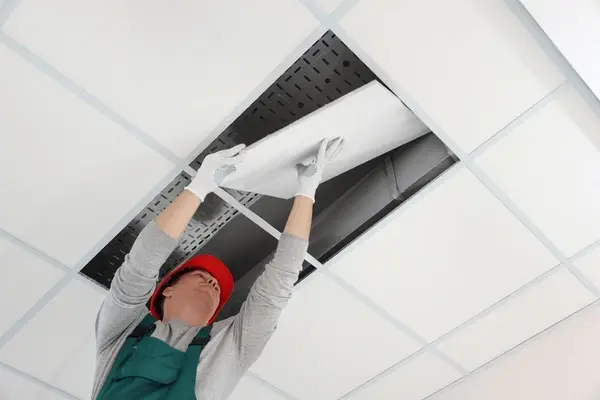
Dubai’s architectural landscape has undergone a remarkable transformation over the past few decades, with gypsum work playing a pivotal role in shaping the city’s unique aesthetic. From the grandeur of traditional Arabic architecture to the sleek lines of modern design, gypsum has been a versatile material that bridges the past with the present. In this article, we delve into the rich history and ongoing evolution of Gypsum work in Dubai, exploring how it has adapted to changing tastes while preserving its cultural significance.
The Historical Significance of Gypsum in Dubai’s Architecture
Gypsum has long been an integral part of Middle Eastern architecture, dating back to ancient civilizations. In Dubai, traditional buildings often featured intricate gypsum carvings and mouldings that reflected Islamic art’s geometric patterns and floral motifs. These elements were not only decorative but also served functional purposes, such as enhancing the acoustic properties of large spaces and providing a cooling effect in hot climates.
Historically, gypsum was prized for its availability and ease of use. It could be locally sourced and applied with simple tools, making it accessible to builders across the region. Gypsum plaster was used extensively in the construction of homes, mosques, and palaces, where it was molded into ornate designs that adorned ceilings, walls, and columns. The craftsmanship involved in these traditional gypsum works was passed down through generations, with artisans dedicating their lives to perfecting their skills.
The Transition to Modern Gypsum Work
As Dubai transitioned from a modest trading port to a global metropolis, the demand for new architectural styles emerged. The traditional gypsum designs, while still cherished, began to evolve to meet the needs of a rapidly modernizing city. The introduction of modern construction techniques and materials led to the development of lightweight gypsum board and prefabricated gypsum panels, which offered greater flexibility and speed in construction.
This transition marked a significant shift in how gypsum was used in architecture. No longer limited to ornate, handcrafted designs, gypsum became a staple in creating sleek, minimalistic interiors. The introduction of false ceilings and gypsum partitions allowed for more creative freedom in interior design, enabling architects to experiment with shapes, textures, and lighting. Modern gypsum work in Dubai is characterized by clean lines, smooth finishes, and an emphasis on functionality, reflecting the city’s embrace of contemporary design trends.
Gypsum in Dubai’s Iconic Landmarks
Dubai is home to some of the world’s most iconic buildings, many of which feature gypsum work as a key design element. From the towering Burj Khalifa to the luxurious interiors of the Burj Al Arab, gypsum has been used to create stunning visual effects that enhance the architectural splendor of these structures.
In the Burj Khalifa, for example, gypsum was used to create custom-designed ceiling features that complement the building’s modern aesthetic. The versatility of gypsum allowed designers to incorporate intricate patterns and lighting elements that add depth and dimension to the space. Similarly, in the Burj Al Arab, gypsum work is prominently featured in the form of ornate mouldings and decorative panels, adding a touch of opulence to the hotel’s interiors.
The Role of Gypsum in Sustainable Architecture
As sustainability becomes a growing concern in the construction industry, gypsum has proven to be an environmentally friendly material that aligns with Dubai’s green building initiatives. Gypsum is a natural, non-toxic material that can be recycled, making it an ideal choice for sustainable construction practices.
In modern architecture, gypsum is often used in conjunction with energy-efficient systems to improve the overall performance of buildings. For example, gypsum boards are commonly used in the construction of insulated wall systems that enhance thermal efficiency and reduce energy consumption. Additionally, the use of gypsum in acoustic ceilings and soundproofing walls helps to create comfortable indoor environments while minimizing the impact on the environment.
Innovations in Gypsum Work: The Future of Interior Design in Dubai
The future of gypsum work in Dubai is bright, with ongoing innovations set to further revolutionize the industry. Advances in 3D printing technology have opened up new possibilities for creating custom gypsum designs with unprecedented precision and complexity. This technology allows for the creation of intricate patterns and shapes that would be impossible to achieve with traditional methods.
Moreover, the development of smart gypsum products is set to transform the way we think about interior design. These products, which include gypsum panels with integrated lighting and temperature control systems, offer a seamless blend of aesthetics and functionality. As Dubai continues to push the boundaries of architectural design, gypsum will undoubtedly remain at the forefront of innovation.
Preserving the Art of Traditional Gypsum Work
While modern innovations are exciting, there is also a growing movement to preserve the art of traditional gypsum work in Dubai. Efforts are being made to document and revive ancient techniques, ensuring that this rich cultural heritage is not lost to time. Artisans are being trained in traditional methods, and there is an increasing appreciation for the craftsmanship involved in creating hand-carved gypsum designs.
In many of Dubai’s restoration projects, traditional gypsum work is being meticulously recreated to preserve the authenticity of historic buildings. This not only honors the city’s architectural past but also provides inspiration for future designs that blend the old with the new.
Conclusion
The evolution of gypsum work in Dubai is a testament to the city’s dynamic architectural landscape. From the intricate carvings of traditional Arabic design to the sleek, modern interiors of today’s skyscrapers, gypsum has played a crucial role in shaping the city’s identity. As Dubai continues to grow and evolve, gypsum will remain an essential material in both preserving the past and building the future.










